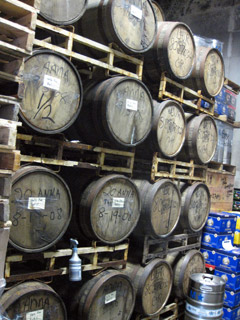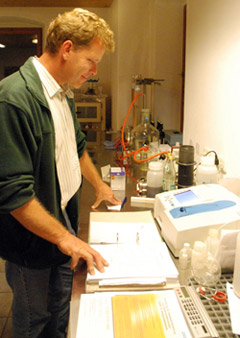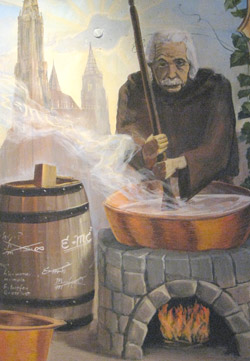 Welcome to my fool’s errand.
Welcome to my fool’s errand.
Last week in the responses to my “The business of beer” post I started a quick exchange with Alan McLeod. I made a reference to a Beer Advocate thread I didn’t have a link to at the time and Alan asked another question I started to answer off the top of my head before I decided collecting a few more facts seemed in order.
As a result I’ve got a mess on my hands. I still don’t really have a definitive answer to to Alan’s questions/statements because it likely doesn’t exists.
So here are the facts. Do with them what you want. (I have an opinion, expressed at the finish).
This began with a fair enough question at Beer Advocate about if Old Rasputin XII from North Coast Brewing — a version of its popular Russian Imperial Stout aged in bourbon barrels — is worth $22 for a half liter bottle, and the responses were interesting if at times curious. I was struck by the logic in a couple of them:
Old Rasputin is a relative bargain in the world of imp. stouts. That makes the pricing of the BA version all the more aggravating. $22 for 500ml?
And . . .
The pricing always left me scratching my head. I understand BA beers cost more to make but you’re talking one of the cheapest RISs out there thrown into some barrels. I know there are cheaper BA RISs where the original version is twice as much as Rasputin.
(Translations: BA means barrel aged and RIS means Russian Imperial Stout.)
Thus I asked: So to justify a higher price for the bourbon barrel should they raise the price of the regular version ($8.99 a 4-pack in our parts, and one great beer bargain)? And Alan responded.
I sent off an email to Mark Ruedrich, one of the founders of North Coast and the brewmaster who wrote the recipe for Old Rasputin, to confirm a few facts (learned when we were in Fort Bragg in June; recently emptied barrels are pictured at the top of this post) and get a little more detail.
– North Coast sold Old Rasputin X and XI only at the brewery and brewpub in Fort Bragg, California (they are across the street from each other). We bought the XI in June for $12.95. We wish we had more.
– This year the brewery packaged Rasputin XII for larger distribution, a little over 2,000 cases (12 bottles a case). They sold out in advance to distributors and not every market North Coast ships to received the beer.
– Distributors will mark up the beer 28 to 32 percent before selling it to retailers, and retailers will mark that up another 30 to 35 percent. Special beers, like Old Rasputin XII tend to get marked up more. Take the middle of both those ranges and you’ll see a bottle of beer delivered to a distributor (which isn’t cheap when the bottle starts in Fort Bragg) for $10 would cost you $17.29 (more likely $16.99 or $17.99). Who’s making the real profit along the way?
– Now as to the difference in price between the “regular” Old Rasputin and one in barrels. Barrels, which hold around 53 gallons, cost $125 and more. They don’t add as much to the price as the fact that California charges $3.30 per gallon tax on the barrel aged beers (same rate as distilled spirits rate) compared to 20 cents per gallon for beer. Still my math indicates barrels and taxes add less than 75 cents to the cost of a half liter. The real expense is how inefficient and labor intensive small-run batches are.
– What’s changed is that if you really wanted to drink Old Rasputin X or XI you had to travel to Fort Bragg (or find somebody to buy you a bottle or three and ship them, only somewhat illegally) and pay $12.95. Today if you live in the right place you can buy it for $5 to $9 more, depending on the largesse of your local distributor and retailer.
Should you? That was the very fair question asked in the Beer Advocate thread. And one you are going to answer yourself.
So we’re back at the beginning, and what follows is opinion.
As I began typing this Ron Pattison wrote, “I don’t want innovative beer. I want tasty, refreshing beer. Beer I want to drink more than a mouthful of. Beer that’s a joy to drink rather than an exercise in endurance.”
I don’t know why a beer can’t be both innovative and tasty, but I appreciate the point he is making. However some people do want the new, new thing (although I’m not sure that 14 years after Goose Island brought Bourbon County Stout to the Great American Beer Festival for the first time that bourbon-barrel beers count at innovative) no matter what.
In this case I don’t think that North Coast is simply taking advantage of that fact. The brewers wanted to do something special for Old Rasputin’s 10th anniversary and priced it accordingly. Ruedrich wanted to package it in a substantial and expensive bottle finished with a cork and cage. As you read earlier, Alan believes such presentation fakes “the price up to create exclusivity.” Sorry, I love the heft of this particular bottle. It adds to my drinking pleasure.
Bottom line, despite the length and detail in this post, North Coast isn’t obligated to provide an explanation for why Rasputin XII costs what it does. After 21 years in business they’ve proved they are pretty good at delivering value (which is why last week construction workers were pouring footings for the new fermenters). Likewise, consumers aren’t obligated to pay $18 or $22 for any bottle of beer.
 We’ll get to the Trader’s Joe beer in a moment, but first other news from Nuremberg, where the
We’ll get to the Trader’s Joe beer in a moment, but first other news from Nuremberg, where the  Ron Pattinson started it: “
Ron Pattinson started it: “ Welcome to my fool’s errand.
Welcome to my fool’s errand.